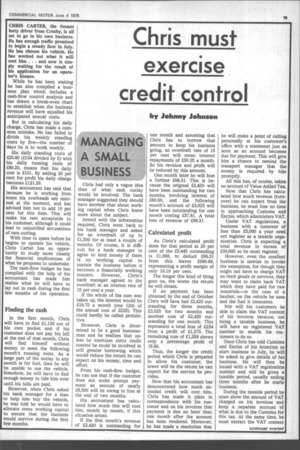Chris must exercise credit control
Page 81

If you've noticed an error in this article please click here to report it so we can fix it.
by Johnny Johnson
one month and assuming that Chris has to borrow that amount to keep his business going, an overdraft rate of 15 per cent will mean interest repayments of £30.25 a month. So his revenue and profit will be reduced by this amount.
One month later he will lose a further £98.31. This is because the original £2,420 will have been outstanding for two months, involving interest of £60.50, and the following month's account of £3,025 will have been outstanding for one month costing £37.81. A total loss of revenue of £98.31.
Calculated profit
As Chris's calculated profit done for that period at 20 per cent of the £5,445 outstanding is £1,089, to deduct £98.31 from this leaves £990.69, representing a profit margin of only 18.19 per cent.
The longer this kind of thing goes on, the worse the return he will obtain.
If no payment has been obtained by the end of October Chris will have had £2,420 outstanding for three months, £3,025 for two months and another sum of £2,420 outstanding for one month. This represents a total loss of £234 from a profit of £1,573. The remaining sum of £1,329 shows only a percentage profit of 16.89.
Thus, the longer the credit period which Chris is prepared to allow his customer, the lower will be the return he can expect for the service he provides.
Now that his accountant has demonstrated how much extended credit will cost him, Chris has made it plain in correspondence with his customer and on his invoices that payment is due no later than one month after the account has been rendered. Moreover, he has made a resolution that he will make a point of calling personally at his customer's office with a statement just as soon as an account becomes due for payment. This will give him a chance to remind the transport manager that the money is required by him promptly.
All this has, of course, taken no account of Value Added Tax.
Now that Chris has calculated how much revenue (turnover) he can expect from the business, he must lose no time in approaching Customs and Excise, which administers VAT.
Under VAT regulations, a business with a turnover of less than £5,000 a year need, not register as a taxable organisation. Chris is expecting a total revenue in excess of £30,000 so he must register.
However, even the smallest business is unwise to invoke the exemption, for though they might not have to charge VAT on their goods or services, they may want to claim back VAT which they have paid for raw materials—in the case of a haulier, on the vehicle he uses and the fuel it consumes.
Nor will his customers be able to claim the VAT content of his invoices because, not being a taxable business, he will have no registered VAT number to enable his customers to do so.
Once Chris has told Customs and Excise of his intention to start business in July, he will be asked to give details of his business. He will then be issued with a VAT registration number and will be given a taxable period, usually ending three months after he starts business.
During the taxable period he must show the amount of VAT charged on his invoices and keep a separate account of what is due to the Customs for this tax. At the same time, he must extract the VAT content
continued over/eat




























































































































